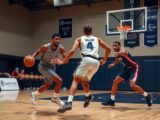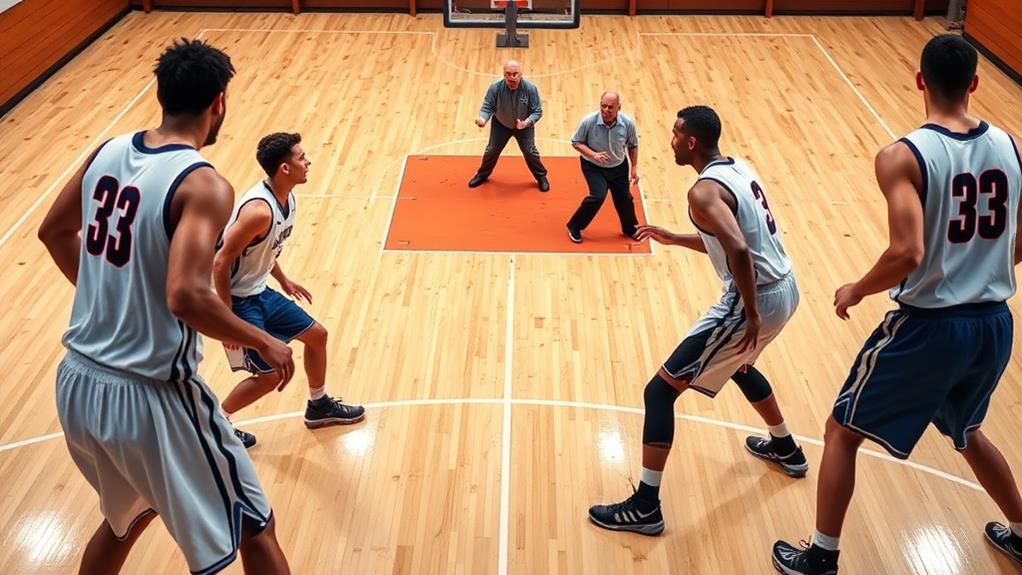
Effective Defensive Basketball Drills for All Players
November 12, 2024To improve your defense in basketball, practice effective drills that focus on individual and team skills. Start with closeouts to contest shots and utilize the Shell Drill for positioning and communication. Incorporating drills like the 4v3 Continuous can simulate real games, enhancing quick decision-making. Don't forget to focus on rebounding techniques to secure the ball. Emphasizing anticipation and reaction skills will elevate your game. Remember, teamwork and communication are key in defensive success. Keep honing these drills to see significant improvements; there's even more to learn about building solid defensive strategies that can transform your play.
Overview of Defensive Drills
When it comes to defensive basketball drills, you want to focus on honing your skills and teamwork to effectively shut down opponents. Implementing a variety of defensive drills is essential for developing both individual defense and team defense. Drills like the Shell Drill and 1-on-1 Closeouts enhance your defensive skills by emphasizing proper positioning and contesting shots.
Additionally, understanding how to adapt to diverse playing styles can further improve your defensive effectiveness, as it allows you to anticipate opponents' moves and strategies, reflecting the significance of global basketball expansion.
Communication is key in these drills; the 4v3 Continuous drill, for example, simulates real-game scenarios that require quick decision-making and strategic defensive positioning. You'll learn how to execute help defense effectively, ensuring that your teammates can rely on you when needed.
Additionally, conditioning is fundamental in defensive drills. Incorporating high-volume closeouts, aiming for 2,000 to 10,000 per season, will improve your reaction time and athleticism, helping you maintain pressure throughout the game.
Don't forget about rebounding; drills like the Box-Out Drill reinforce effective techniques, allowing you to secure possession after defensive stops. With consistent practice of these drills, you'll elevate your game and contribute to a strong defensive presence on the court.
Key Individual Defensive Techniques
To become a strong defender, you need to master key techniques like closeout fundamentals and body positioning.
As the game evolves, the importance of effective communication and teamwork in defensive strategies can't be overstated.
These skills will help you anticipate offensive moves and react quickly during gameplay.
Closeout Fundamentals
In defensive basketball, mastering closeout fundamentals is essential for effectively contesting shots and limiting scoring opportunities. Closeouts are vital maneuvers where you sprint toward the ball handler to contest their shot, considerably reducing their chances of scoring. In fact, effective closeouts can decrease shooting percentages by up to 30%.
As a defender, you should maintain high hands during closeouts to disrupt passing lanes and shot opportunities. Proper footwork is important here; take long strides to cover ground quickly while staying balanced. This allows you to adjust your positioning based on the offensive player's movements.
In addition, focus on containing the ball handler by forcing them toward the sideline. This limits their options and creates opportunities for help defense from your teammates.
Consistent practice is key; aim for 2,000 to 10,000 repetitions of closeout techniques each season. Doing so will greatly enhance your defensive fundamentals and overall team performance.
Body Positioning Techniques
Proper body positioning is essential for effective defensive play, allowing you to respond quickly to the offensive player's movements. As a defender guarding an opponent, you should adopt a low and wide stance. This stance enhances your balance and enables quick lateral movements, critical for solid defensive footwork.
Face the offensive player with your chest and maintain an arm's length distance. This positioning helps you react promptly, contest shots, and deny passes effectively.
Anticipating offensive movements is important. Position yourself to force the offensive player toward the sideline, which minimizes their driving opportunities into the paint. Utilize the "mirror" technique by closely matching the offensive player's movements; maintain eye contact and adjust your position accordingly.
To develop these body positioning skills, incorporate consistent practice of defensive drills, such as the Defensive Stance Drill. This drill enhances muscle memory and improves your overall efficiency as a defensive player in game situations.
Anticipation and Reaction Skills
Mastering body positioning sets the foundation for developing anticipation and reaction skills in defense. As a defensive player, honing your anticipation skills means learning to read the offensive player's body language and tendencies. This ability will help you predict their movements and react swiftly to disrupt plays.
Drills like the "1-on-1 Closeouts Drill" enhance your reaction skills by training you to adjust your positioning and contest the shot after sprinting to close out on an opponent.
Maintaining a low and wide stance is vital for improving your balance and reaction time. This stance allows you to pivot and shift directions more efficiently during gameplay.
Incorporating drills that simulate game scenarios, such as the "Pass Denial Drill," is essential for practicing your anticipation and reaction skills under pressure. These drills enable you to intercept passes and deny scoring opportunities effectively.
Consistent practice of these techniques can lead to significant improvements in defensive efficiency. By capitalizing on offensive mistakes and creating turnovers through timely interventions, you can elevate your game and become a more formidable defender on the court.
Essential Team Defense Drills
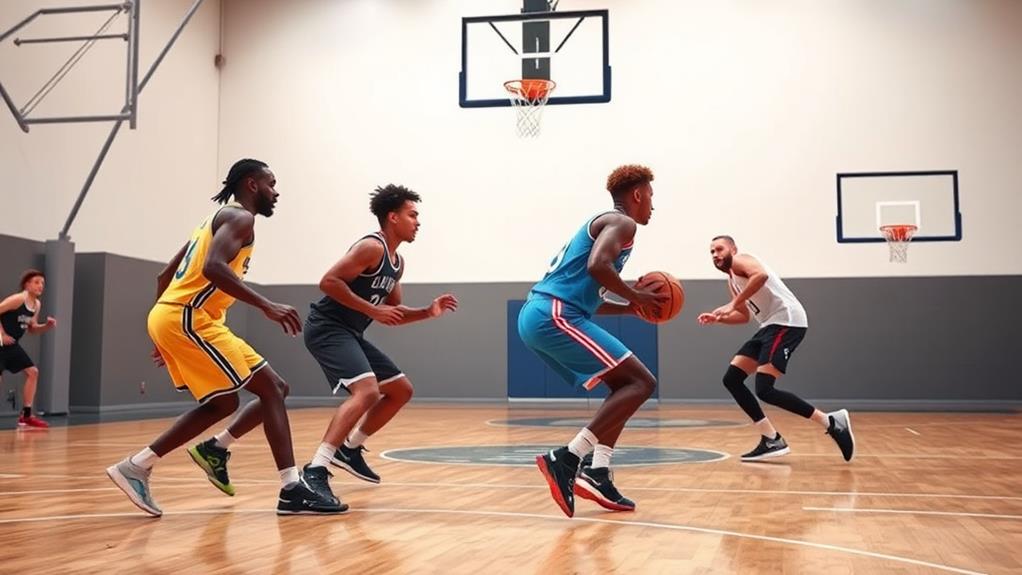
Incorporating essential team defense drills is vital for building a strong defensive unit.
Strengthening your defense is pivotal, as building a strong soccer defence tips can also apply to basketball.
The Shell Drill enhances your positioning and communication skills, helping you read offensive movements effectively.
When you practice in live game scenarios, like the 5 on 5 Positioning Drill, you'll learn to execute your defensive roles under pressure.
Shell Drill Importance
The Shell Drill serves as a cornerstone for building effective team defense, allowing players to simulate real-game scenarios while honing their defensive skills. This foundational exercise enhances defensive positioning by requiring you to respond to various offensive movements.
As you practice the shell drill, communication becomes essential; you'll need to call out screens, cuts, and switches to guarantee you and your teammates execute your defensive responsibilities effectively.
Moreover, the shell drill incorporates principles of help defense, teaching you when to rotate and support your teammates, thereby preventing scoring opportunities. By regularly practicing this drill, you'll greatly improve your overall defensive awareness, helping you react quickly to offensive plays during games.
Coaches often utilize the shell drill as a platform to teach more advanced defensive concepts, establishing a clear understanding of spatial awareness and defensive roles on the court.
As you engage in this drill, you'll not only refine your individual skills but also foster a cohesive team environment, ultimately strengthening your team's overall defensive performance. Embrace the shell drill, and watch your team's defense flourish!
Positioning and Communication
Building on the foundation established by the Shell Drill, effective positioning and communication are vital components of team defense that can greatly elevate your game. When all five players understand their roles and actively communicate, you strengthen your defensive structure against offensive movements.
The Shell Drill is a fantastic way to enhance this understanding, teaching you to read offensive plays while promoting clear communication for help defense.
Incorporating the 5 on 5 Positioning Drill in practice further sharpens your team's coordination. This drill requires you to stay engaged, maintaining constant communication and awareness of your teammates' positions.
By developing a defensive language, you can quickly convey assignments and support each other during fast-paced situations, effectively preventing offensive cuts.
Continuous practice of positioning and communication drills will lead to improved defensive coordination, reducing scoring opportunities for your opponents.
As you work together, you'll foster not only better defensive skills but also an overall sense of confidence as a team.
Live Game Scenarios
To excel in defensive basketball, practicing live game scenarios is essential for developing teamwork and quick decision-making.
These drills simulate realistic challenges that players face during games, helping to reinforce communication and team defensive concepts. Here are some effective drills to incorporate into your practice:
- 4 on 3 Overload Drill: Defenders work on scrambling and communicating under numerical disadvantages.
- No Paint Defense Drill: Focuses on preventing offensive penetration, enhancing positioning and awareness.
- Five on Five Whistle Change: Players switch defensive assignments when a whistle blows, fostering adaptability.
- 1 on 1 to 3 on 3 Full Court Drill: Teaches maintaining defensive pressure and effective defensive flow.
- Shell Drill: Covers ball defense, help defense, and proper rotations, allowing players to read offensive movements.
Transition Defense Strategies
Effective shift defense hinges on players' ability to quickly recognize offensive threats and react accordingly. In counter-defense, you need to sprint back to establish your positioning before the offense sets up. Communication is essential here; alert your teammates about assignments and potential threats. This teamwork can drastically reduce scoring opportunities during fast breaks.
Incorporating soccer moves guide can also help in understanding the movement patterns of offensive players, enhancing your defensive strategies.
To enhance your skills, practice drills like the "1 on 1 to 3 on 3 Full Court." These drills simulate real-game scenarios, helping you develop quick decision-making and maintain defensive pressure across the court. Focus on containing the ball handler by forcing them toward the sideline, limiting their options and creating opportunities for your teammates to establish help-side defense.
Additionally, consistent practice of defensive closeouts will sharpen your ability to contest shots effectively. Incorporate sprinting drills into your routine to improve your conditioning, enabling you to sustain high levels of intensity during counter-defense situations.
Competitive Game Scenario Drills
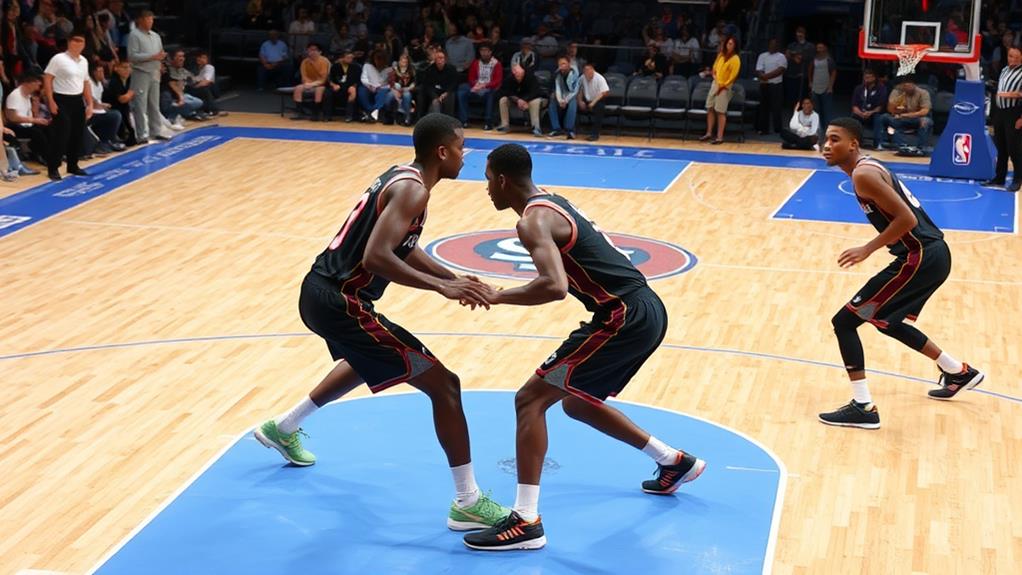
In competitive basketball, players often find themselves in high-pressure situations that test their defensive skills and teamwork. Engaging in Competitive Game Scenario Drills can sharpen your abilities and prepare you for real-game intensity, just as understanding the 3 Essential Rules of Soccer can enhance your overall sports knowledge.
Here are some effective drills to take into account:
- 4 on 3 Overload Drill: This drill simulates being outnumbered, requiring you to scramble and communicate effectively.
- No Paint Defense Drill: Focus on eliminating offensive penetration, rewarding the offense for successful drives, which teaches you the importance of protecting the paint.
- 5 on 5 Whistle Change Drill: This drill emphasizes defensive versatility as players scramble and switch assignments based on the coach's whistle, enhancing awareness.
- 1 on 1 to 3 on 3 Full Court Drill: Develops individual and team defensive skills while maintaining pressure across the court.
- Competitive Scoring Systems: Incorporate points for defensive stops or successful rebounds to keep everyone engaged and accountable.
Rebounding and Box-Out Techniques
Rebounding is vital in basketball, and mastering box-out techniques can make all the difference in gaining possession. To effectively secure rebounds, you need to maintain a low center of gravity and use your body positioning to create space against opponents before the shot is taken.
Racial integration in sports has also shown how diverse backgrounds can enhance teamwork and communication among players, further emphasizing the importance of collaboration in drills like these promotes teamwork and mutual respect.
Box-out drills are important for teaching players how to establish contact with their opponents and use their bodies to form a barrier, ensuring they can secure the rebound once the shot is missed.
As a player, focus on anticipating where the ball will land after a shot. This anticipation allows you to position yourself strategically for ideal rebounding opportunities.
Incorporating drills that simulate game scenarios, like the "Box-Out Drill," reinforces the importance of physicality and awareness in securing rebounds during competitive play. Consistent practice of these box-out techniques will greatly improve your team's rebounding statistics, making it easier to limit second-chance points for opponents.
Importance of Communication
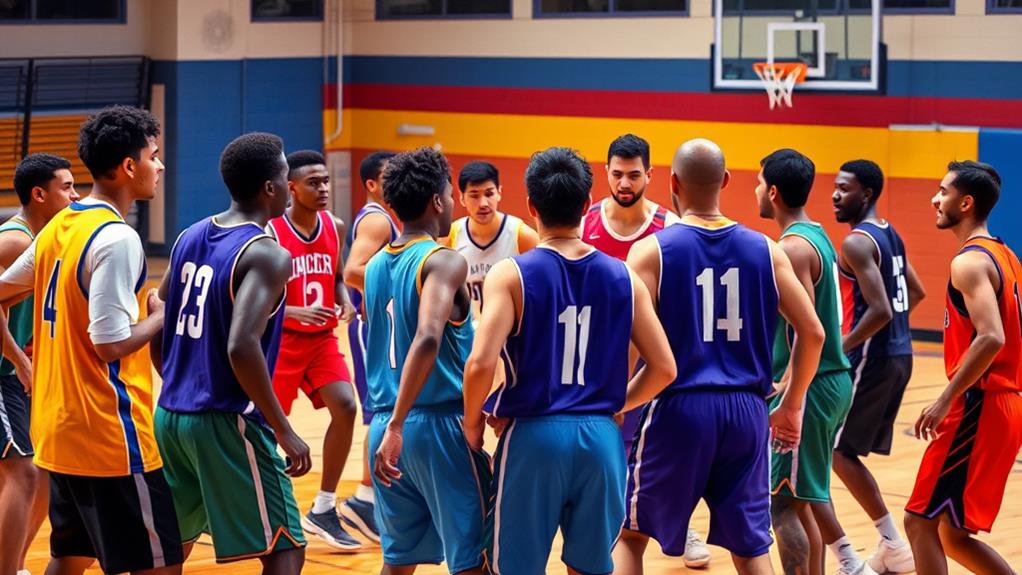
While playing defense, communication becomes essential for success on the court. It's your lifeline to executing defensive concepts effectively. When you and your teammates talk, you reduce scoring opportunities for opponents and make defensive stops more likely.
Effective communication allows teams to adapt to strict defenses, creating favorable scoring chances for themselves and disrupting the opponent's flow of play, leading to smart defensive tactics.
- Alert teammates to screens and cuts
- Foster a culture of accountability
- Enhance teamwork and responsiveness
- Create a tailored defensive language
- Improve defensive coordination through feedback
As a defender, you must convey your assignments and roles clearly. Players must be proactive in discussing threats and strategies, ensuring everyone understands their responsibilities. This continuous dialogue builds accountability, where each player feels responsible for their tasks and supports one another.
Moreover, establishing a defensive language specific to your team's principles helps streamline communication, especially in high-pressure situations.
You'll find that the more you communicate, the more effective your defensive efforts become. Regular discussions about how well you're communicating can lead to significant improvements in your overall team performance.
When you embrace the importance of communication, you empower your team to excel on defense and create opportunities for victory.
Advanced Defensive Concepts
Advanced defensive concepts are essential for elevating your team's performance on the court. Techniques like the Tight Shell and the Slide Run Slide Drill help you navigate screens and recover from being beaten on defense. By practicing these drills, you'll learn to stay connected to offensive players, enhancing your overall defensive effectiveness.
Additionally, mastering key principles such as effective marking and pressing can translate these techniques into a more cohesive team defense.
Implementing Shell Downscreen and Shell Backscreens drills is imperative for honing your defensive communication skills. These exercises focus on footwork and positioning, which are critical for maintaining defensive integrity during various offensive movements.
You'll quickly learn to adapt to opposing players' actions while staying alert for screens.
The 4v3 Continuous drill takes things up a notch, forcing you to make quick decisions under pressure while enhancing defensive communication. This drill simulates real-game scenarios, pushing you to think critically and react swiftly.
Mastering these advanced defensive techniques contributes considerably to your team's overall defensive efficiency. By incorporating these concepts into your training, you'll be better prepared for high-stakes situations, ultimately leading to a stronger, more cohesive defense on the court.
Resources for Coaches and Players
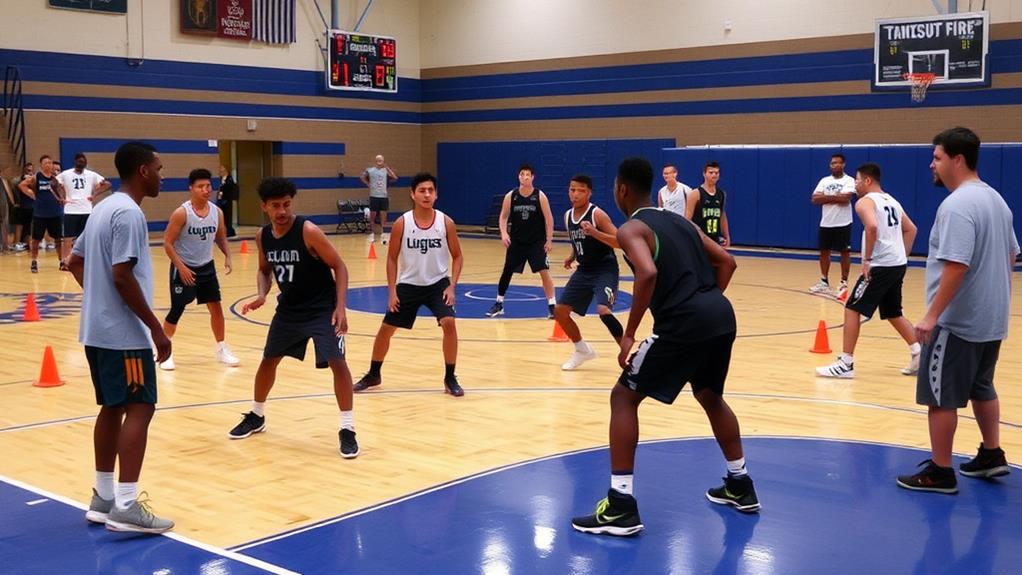
Coaches and players looking to strengthen their defensive skills have a wealth of resources at their fingertips. Incorporating drills that emphasize defensive stance and agility can greatly enhance overall performance.
Whether you're working with youth players or advanced teams, these tools can enhance your team's ability to stay focused and effective on defense.
- Team Defense Drillbook: 26 drills with step-by-step instructions and diagrams.
- Individual Defense Drillbook: Tailored exercises for personal skill enhancement.
- Free PDF: Access additional defensive drills and tips for quick development.
- Engaging Drills: Designed to improve basketball skills while emphasizing teamwork.
- Privacy Assured: Enjoy 100% privacy when requesting drills, fostering a secure sharing environment.
Conclusion
In basketball, defense is your sturdy shield, protecting the team's goal while empowering every player. By mastering these drills and techniques, you're crafting a fortress where communication and teamwork reign supreme. Just as a well-trained knight anticipates an opponent's move, you'll develop instincts that turn challenges into victories. Keep honing your skills, and watch as your defensive prowess transforms your game, making you an unbreakable wall on the court, ready to face any opponent that comes your way.

